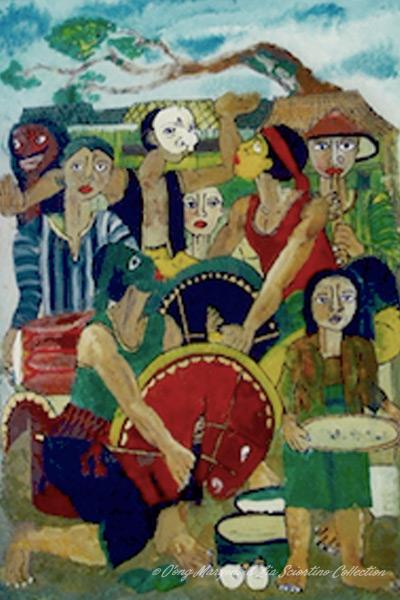| Collection Number | 29 |
| Title | Kuda Lumping/Flat horse dance |
| Time | 1990 |
| Time Acquisition | 1994 |
| Place | Unknown |
| Place of Acquisition | Kalinga Antique Shop, Jl. Parangritis 12A, Jogjakarta, Jogjakarta, indonesia |
| Name Painter (Place and Year of Birth-Death) |
Unknown |
| Size | 33cm x 47cm |
| Category (Sub-Category) |
Art (Dance) |
| Current Location | Palermo, Italy (Home) |
| Description | Kuda Lumping is a Javanese trance dance performance. In different parts of Java it has s different names, among which the most common are jathilan (specific to Yogyakarta region), kuda kepang and kuda lumping in Central Java and Jaranan in East Java. Both: ‘jaran’ in Javanese and ‘kuda’ in Indonesian mean horse, for flat hobby horses (generally made of woven bamboo) are an essential part of the performance.
Kuda Lumping is performed in traditional village ceremonies of transition for births, circumcision, marriage, house dedication and death. In the performance dancers act out riding flat effigies of horses and fight each other, with some going into trance, possessed by the spirit of the horses. The pawang or dukun (healer/medium) is believed to be summoning spirits that enter the bodies of the dancers. He is the most important person in the troupe and the one who makes performances happen in both: mystical and material way – for pawang usually are also troupe’s producers and even the owners of the props. The performance consists of several parts: in the beginning it is merely a dance where the horse effigies are involved, but then the phase that is meant to induce trance – by music and chanting – follows and after those who didn’t become possessed leave, the dancers who stay act according to the desires of the spirits possessing them: eat, drink, dance to the music, but also perform various feats like walking over hot coals, tearing big green coconuts apart with bare hands and teeth or eating glass. In the end the pawang and his helpers make sure that spirits leave peacefully. |

